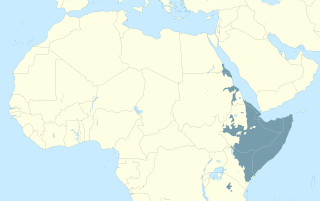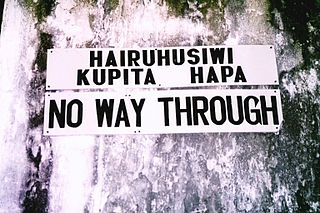Related Research Articles

The Cushitic languages are a branch of the Afroasiatic language family. They are spoken primarily in the Horn of Africa, with minorities speaking Cushitic languages to the north in Egypt and the Sudan, and to the south in Kenya and Tanzania. As of 2012, the Cushitic languages with over one million speakers were Oromo, Somali, Beja, Afar, Hadiyya, Kambaata, Saho, and Sidama.

The Nauruan or Nauru language is an Austronesian language, spoken natively in the island country of Nauru. Its relationship to the other Micronesian languages is not well understood.

Hadza is a language isolate spoken along the shores of Lake Eyasi in Tanzania by around 1,000 Hadza people, who include in their number the last full-time hunter-gatherers in Africa. It is one of only three languages in East Africa with click consonants. Despite the small number of speakers, language use is vigorous, with most children learning it, but UNESCO categorizes the language as vulnerable.
The South Cushitic or Rift languages of Tanzania are a branch of the Cushitic languages. The most numerous is Iraqw, with half a million speakers. These languages are believed to have been originally spoken by Southern Cushitic agro-pastoralists from Ethiopia, who began migrating southward into the Great Rift Valley in the third millennium BC.
The Asa (Aasá) language, commonly rendered Aasax, was spoken by the Asa people of Tanzania. The language is extinct; ethnic Assa in northern Tanzania remember only a few words they overheard their elders use, and none ever used it themselves. Little is known of the language; what is recorded was probably Aasa lexical words used in a register of Maasai like the mixed language Mbugu.

The Iraqw People (; are the Cushitic-speaking ethnic group inhabiting the northern Tanzanian regions. They are a significant group in originating in southwestern Arusha and Manyara regions of Tanzania, near the Rift Valley. The Iraqw people settled in the southeast of Ngorongoro Crater in northern Karatu District, Arusha Region, where they remain the majority ethnic group. In Manyara region, the Iraqw are a major ethnic group in Mbulu District, Babati District and Hanang District.
The Alagwa are an ethnic group mostly based in the Kondoa District of the Dodoma Region in central Tanzania, an area well known for rock art. Smaller numbers of Alagwa reside in the Hanang district of the Manyara Region in Tanzania, as well. They speak the Alagwa language as a mother tongue, which belongs to the South Cushitic branch of the Afro-Asiatic family. In 2022, the Alagwa population was estimated to number 52,816 individuals, and Mous (2016) estimates the number of speakers to be slightly over 10,000.
Gorowa is a Cushitic language spoken in Tanzania in the Dodoma and Manyara Regions.

Iraqw (;) is a Cushitic language spoken in Tanzania in the Arusha and Manyara Regions. It is expanding in numbers as the Iraqw people absorb neighbouring ethnic groups. The language has many Datooga loanwords, especially in poetic language. The Gorowa language to the south shares numerous similarities and is sometimes considered a dialect.
Datooga is a Nilotic language or dialect cluster of the Southern Nilotic group. It is spoken by the Datooga people of the Great Rift Valley of Tanzania. The Sukuma name Taturu is also sometimes used in English; the Swahili name Mang'ati comes from Maasai, where it means "enemy". However, it is not considered offensive to the Datooga, as there is a degree of pride in being the historic enemy of the Maasai, and Mang'ati has become the standard name for the group in Swahili. In addition, numerous tribal and dialectal names may be found for the people or language as a whole.
Koalib is a Niger–Congo language in the Heiban family spoken in the Nuba Mountains of southern Sudan. The Koalib Nuba, Turum and Umm Heitan ethnic groups speak this language.
Mbugwe or Mbuwe (Kimbugwe) is a Bantu language of spoken by the Mbugwe people of Lake Manyara in the Manyara Region of Central Tanzania. Mbugwe is estimated to be spoken by some 34,000 people.
Mbe is a language spoken by the Mbube people of the Ogoja, Cross River State region of Nigeria, numbering about 65,000 people in 2011. As the closest relative of the Ekoid family of the Southern Bantoid languages, Mbe is fairly close to the Bantu languages. It is tonal and has a typical Niger–Congo noun-class system.

Tanzania is a multilingual country. There are many languages spoken in the country, but no one language is spoken natively by a majority or a large plurality of the population. Swahili and English, the latter of which was inherited from colonial rule, are widely spoken as lingua francas. They serve as working languages in the country, with Swahili being the official national language. There are more speakers of Swahili than of English in Tanzania.
Kakabai is an Austronesian language spoken in Milne Bay Province of Papua New Guinea.
Kaninuwa, or Wataluma, is a major Oceanic language of Goodenough Island, Papua New Guinea.
Buhutu (Bohutu) is an Oceanic language spoken in Milne Bay Province of Papua New Guinea. Most Buhutu speakers live in the Sagarai River Valley between Mullins Harbour on the south coast and the Pima mountains north of the Sagarai.
Mbulu is a town in Tanzania and the capital of the Mbulu District. The town is inhabited by the Iraqw people. The Roman Catholic Diocese of Mbulu is also in Mbulu.